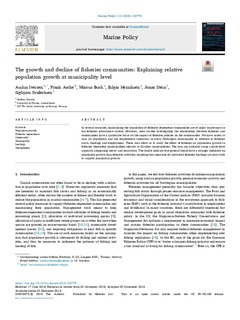| dc.contributor.author | Iversen, Audun | |
| dc.contributor.author | Asche, Frank | |
| dc.contributor.author | Buck, Marcus | |
| dc.contributor.author | Henriksen, Edgar | |
| dc.contributor.author | Stein, Jonas | |
| dc.contributor.author | Svalestuen, Sigbjørn | |
| dc.date.accessioned | 2020-01-08T09:18:47Z | |
| dc.date.available | 2020-01-08T09:18:47Z | |
| dc.date.created | 2020-01-02T10:04:18Z | |
| dc.date.issued | 2020-02 | |
| dc.identifier.citation | Iversen, A., Asche, F., Buck, M. et al. (2020) The growth and decline of fisheries communities: Explaining relative population growth at municipality level. Marine Policy, 112 | nb_NO |
| dc.identifier.issn | 0308-597X | |
| dc.identifier.uri | http://hdl.handle.net/11250/2635242 | |
| dc.description.abstract | In several countries, maintaining the population of fisheries dependent communities are of major importance in the fisheries governance system. However, most studies investigating the relationship between fisheries and communities have a qualitative focus on the impact of fisheries policies on the communities. We have access to data on population and key employment indicators of every Norwegian municipality in addition to fisheries catch, landings and employment. These data allow us to study the effect of fisheries on population growth in fisheries dependent municipalities relative to all other municipalities. The data are analyzed using a multi-level approach integrating micro- and macrodata. The results indicate that general trends have a stronger influence on population growth than fisheries activities, implying that measures for increased fisheries landings are poor tools to support population growth. | nb_NO |
| dc.language.iso | eng | nb_NO |
| dc.publisher | Elsevier B.V. | nb_NO |
| dc.rights | Attribution-NonCommercial-NoDerivatives 4.0 Internasjonal | * |
| dc.rights.uri | http://creativecommons.org/licenses/by-nc-nd/4.0/deed.no | * |
| dc.subject | population growth | nb_NO |
| dc.subject | fisheries dependence | nb_NO |
| dc.subject | municipality | nb_NO |
| dc.subject | befolkningsvekst | nb_NO |
| dc.title | The growth and decline of fisheries communities: Explaining relative population growth at municipality level | nb_NO |
| dc.type | Journal article | nb_NO |
| dc.type | Peer reviewed | nb_NO |
| dc.description.version | publishedVersion | nb_NO |
| dc.rights.holder | © 2019 The Authors | nb_NO |
| dc.subject.nsi | VDP::Social science: 200::Economics: 210 | nb_NO |
| dc.subject.nsi | VDP::Agriculture and fishery disciplines: 900::Fisheries science: 920 | nb_NO |
| dc.source.volume | 112 | nb_NO |
| dc.source.journal | Marine Policy | nb_NO |
| dc.identifier.doi | https://doi.org/10.1016/j.marpol.2019.103776 | |
| dc.identifier.cristin | 1764937 | |
| dc.relation.project | EC/H2020/635761 | nb_NO |
| dc.relation.project | Fiskeri- og havbruksnæringens forskningsfinansiering: 901266 | nb_NO |
| dc.relation.project | Nordisk Råd: (158)-2017 | nb_NO |
| cristin.unitcode | 217,8,3,0 | |
| cristin.unitname | Institutt for sikkerhet, økonomi og planlegging | |
| cristin.ispublished | true | |
| cristin.fulltext | original | |
| cristin.qualitycode | 1 | |

